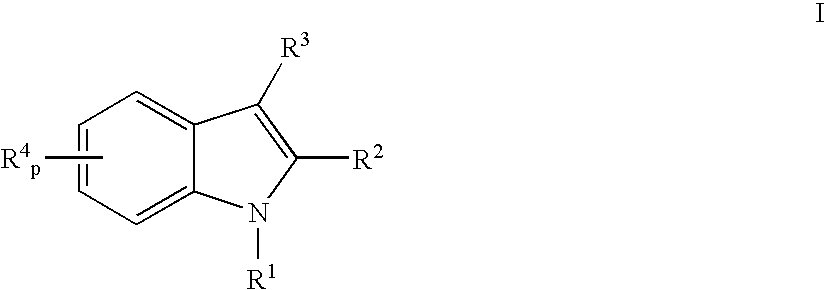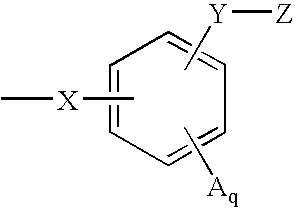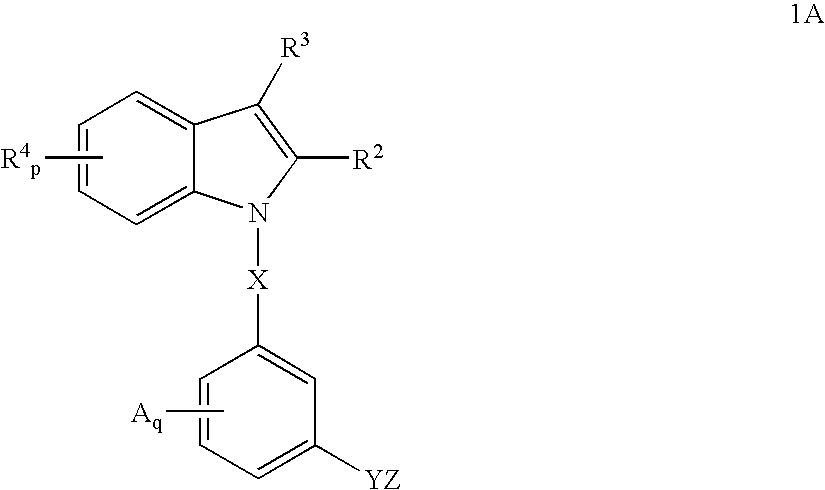Indoles having anti-diabetic activity
a technology of indoles and insulin, which is applied in the field of indoles, can solve the problems of increased and premature morbidity and mortality, elevated plasma insulin levels that are not sufficient to overcome the pronounced insulin resistance, and the serum glucose level is not elevated enough to meet the criteria of type 2 diabetes, etc., to achieve impaired glucose tolerance, lowering glucose, lipids and insulin
- Summary
- Abstract
- Description
- Claims
- Application Information
AI Technical Summary
Benefits of technology
Problems solved by technology
Method used
Image
Examples
example 1
[0246]
(2R)-2-{3-[3-(4-methoxy)benzoyl-2-methyl-6-(trifluoromethoxy)-1H-indol-1-yl]phenoxy} propanoic acid
[0247]Step 1: 1-(3-methoxy)phenyl-2-methyl-6-trifluoromethoxyindole (1): 2-Methyl-6-trifluoromethoxyindole (645 mg, 3.0 mmole), 3-bromoanisole (0.456 ml, 3.6 mmole), sodium t-butoxide (404 mg, 4.2 mmole), trisdibenzylidine dipalladium (206 mg, 0.225 mmole) and 2-di-t-butylphosphinobiphenyl (201 mg, 0.675 mmole) were stirred in toluene at 80° C. and monitored by LC (3 / 1 hexanes / methylene chloride) or reversed phase HPLC until complete. The reaction mixture was then cooled, filtered over celite, and the filtrate evaporated to give a crude isolate, which was purified by silica gel chromatography to give the title compound.
[0248]1H NMR (500 MHz, CDCl3): δ 7.53 (d, Ph, 1H), 7.48 (t, Ph, 1H), 7.05 (dd, Ph, 1H), 7.02 (m, Ph, 2H), 6.95 (dd, ph, 1H), 6.89 (t, Ph, 1H), 6.42 (s, Ph, 1H), 3.88 (s, OCH3, 3H), 2.33 (s, 2-CH3, 3H).
[0249]Step 2: 1-(3-hydroxy)phenyl-2-methyl-6-trifluoromethoxyind...
example 2
[0257]
(2S)-2-{3-[3-(4-methoxy)benzoyl-2-methyl-6-(trifluoromethoxy)-1H-indol-1-yl]phenoxyy} propanoic acid
[0258]This compound was made using a synthetic method analogous to Example 1 and using readily available reagents and starting materials. Such a synthesis can be readily carried out by a practitioner in the field of synthetic organic chemistry.
[0259]1H NMR (500 MHz, CDCl3): δ 7.87 (d, Ph, 2H), 7.54 (t, Ph, 1H), 7.45 (br s, Ph, 1H), 7.11 (br s, Ph, 1H), 7.02 (m, Ph, 411), 6.95 (m, Ph, 21), 4.88 (br m, OCH(CH3)CO2H, 1H), 3.93 (s, OCH3, 3H), 2.41 (s, 2-CH3, 3H), 1.74 (d, OCH(CH3)CO2H, 3H). RP LC / MS: tR=3.88 min, m / e 514 (M+1)
Example 3
[0260]
example 3
[0261]
(2R)-2-{3-[3-(4-methoxy)benzopyl-2-methyl-6-(trifluoromethoxy)-1H-indol-1-yl]phenoxy}butanoic acid
[0262]Step 1: 1-(3-methoxyphenyl-2-methyl-6-trifluoromethoxyindole (1): 2-Methyl-6-trifluoromethoxyindole (645 mg, 3.0 mmole), 3-bromoanisole (0.456 ml, 3.6 mmole), sodium t-butoxide (404 mg, 4.2 mmole), trisdibenzylidine dipalladium (206 mg, 0.225 mmole) and 2-di-t-butylphosphinobiphenyl (201 mg, 0.675 mmole) were stirred in toluene at 80° C. and monitored by TLC (3 / 1 hexanes / methylene chloride) or reversed phase HPLC until complete. The reaction mixture was then cooled, filtered over celite, and the filtrate evaporated to give a crude isolate, which was purified by silica gel chromatography to give the title compound.
[0263]1H NMR (500 MD, CDCl3): δ 7.53 (d, Ph, 1H), 7.48 (t, Ph, 1H), 7.05 (dd, Ph, 1H), 7.02 (m, Ph, 2H), 6.95 (dd, ph, 1H), 6.89 (t, Ph, 1H), 6.42 (s, Ph, 1H), 3.88 (s, OCH3, 3H), 2.33 (s, 2-CH3, 3H).
[0264]Step 2: 1-(3-hydroxy)phenyl-2-methyl-6-trifluoromethoxyindol...
PUM
| Property | Measurement | Unit |
|---|---|---|
| volume | aaaaa | aaaaa |
| concentrations | aaaaa | aaaaa |
| flow rate | aaaaa | aaaaa |
Abstract
Description
Claims
Application Information
 Login to View More
Login to View More - R&D
- Intellectual Property
- Life Sciences
- Materials
- Tech Scout
- Unparalleled Data Quality
- Higher Quality Content
- 60% Fewer Hallucinations
Browse by: Latest US Patents, China's latest patents, Technical Efficacy Thesaurus, Application Domain, Technology Topic, Popular Technical Reports.
© 2025 PatSnap. All rights reserved.Legal|Privacy policy|Modern Slavery Act Transparency Statement|Sitemap|About US| Contact US: help@patsnap.com



